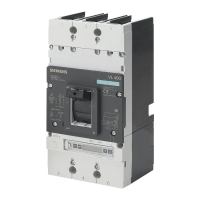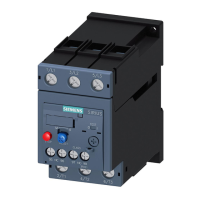Parameter assignment / addressing
9.1 Setting the parameters
3VL IEC molded case circuit breakers
System Manual, 11/2013, 110 0110 - 02 DS 03
121
Effect on
characteristic curve
I
g
/t
g
Tripping current and
time delay of the
ground-fault protection
I
g
= Off, 1 or 0.6 x I
n
t
g
=
Off, 0.1 s or 0.3 s
Protection from short-circuit to
ground and thus prevention of
arcs. Ground-fault protection is
part of the fire protection.
1)
For LCD ETUs, the ST function must be set to the value "disabled" for t
sd
= 0.
Setting of the protection parameter for line and generator protection
The settings are variable depending on the trip unit (ETU10, ETU12, ETU20, ETU22, LCD-
ETU40 and LCD-ETU42). The following parameters can be set depending on the version:
R
The overload release I
R
is set to the operating current I
B
of the circuit to be protected. This
takes place with the help of the left rotary encoding switch I
R
that is set to the factor I
B
/I
n
(example: I
B
= 250 A, I
n
= 315 A => setting factor 250 / 315 = 0.79 corresponds to 0.8 on the
rotary encoding switch).
r
The delay time (or time-lag class) t
r
can be set using another rotary encoding switch. The set
time is the tripping time at 6 x I
r
. In this way, selectivity to other molded case circuit breakers
can be achieved in the overload range, for example, when the rated current range does not
differ much.
S short-time delayed short-circuit protection I
sd
The short-time delay short-circuit protection can be set with regard to the tripping value of
the current I
sd
and the delay time t
sd
. I
sd
refers to the tripping value of the overload release I
R
and can be set between 1.5 to 10 x I
R
(depending on the molded case circuit breaker).
sd
Depending on the requirements and on the trip unit, selectivity to the other molded case
circuit breakers can be achieved with appropriate selection of the delay time t
sd
. If the rotary
encoding switch is in the "ON" range, this means the delay time is current-dependent. The I
2
t
value is constant. For example, the higher the current, the faster the circuit breaker will trip
(equivalent to the overload release I
R
). In contrast, the delay time in the "OFF" position is
current-independent, that is, constant. If the current reaches the set value I
sd
, the circuit
breaker trips after the set time t
sd
. The degree to which the current exceeds the value I
sd
is
not important. The set time is the tripping time at 8 x I
r
.

